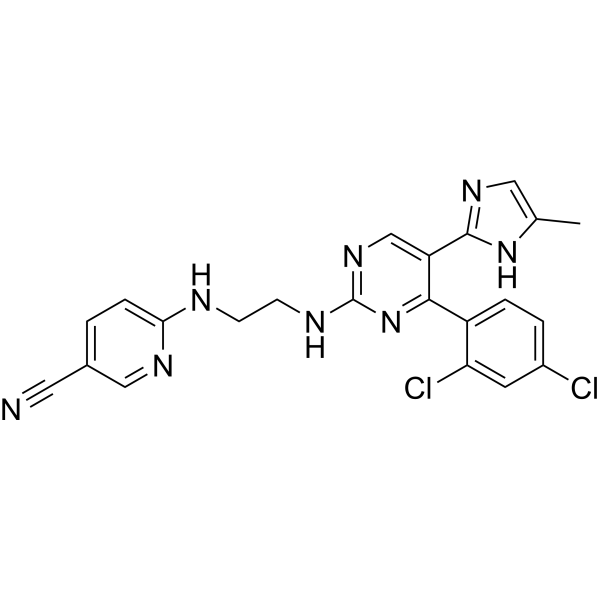Home
Products
CHIR-99021 (CT99021)



| Product Name | CHIR-99021 (CT99021) |
| Price: | Inquiry |
| Catalog No.: | CN00539 |
| CAS No.: | 252917-06-9 |
| Molecular Formula: | C22H18Cl2N8 |
| Molecular Weight: | 465.34 g/mol |
| Purity: | >=98% |
| Type of Compound: | Alkaloids |
| Physical Desc.: | Powder |
| Source: | |
| Solvent: | Chloroform, Dichloromethane, Ethyl Acetate, DMSO, Acetone, etc. |
| SMILES: | N#Cc1ccc(nc1)NCCNc1ncc(c(n1)c1ccc(cc1Cl)Cl)c1[nH]cc(n1)C |
| Contact us | |
|---|---|
| First Name: | |
| Last Name: | |
| E-mail: | |
| Question: | |
| Description | CHIR-99021 is a GSK-3α/β inhibitor with an IC50 of 10 and 6.7 nM,showing 500-fold selectivity over its closest homologs CDC2 and ERK2, as well as other protein kinases. |
| Target | GSK-3β:6.7 nM (IC50) GSK-3α:10 nM (IC50) cdc2:8800 nM (IC50) |
| In Vitro | CHIR 99021inhibits human GSK-3β with Ki values of 9.8 nM[1]. CHIR 99021 is a small organic molecule that inhibits GSK3α and GSK3β by competing for their ATP-binding sites.In vitro kinase assays reveal that CHIR 99021 specifically inhibits GSK3β (IC50=~5 nM) and GSK3α (IC50=~10 nM), with little effect on other kinases[2]. In the presence of CHIR-99021 the viability of the ES-D3 cells is reduced by 24.7% at 2.5 μM, 56.3% at 5 μM, 61.9% at 7.5 μM and 69.2% at 10 μM CHIR-99021 with an IC50 of 4.9 μM[3]. |
| In Vivo | In ZDF rats, a single oral dose of CHIR 99021 (16 mg/kg or 48 mg/kg) rapidly lowers plasma glucose, with a maximal reduction of nearly 150 mg/dl 3-4 h after administration[1]. CHIR99021 (2 mg/kg) given once, 4 h before irradiation, significantly improves survival after 14.5 Gy abdominal irradiation (ABI). CHIR99021 treatment significantly blocks crypt apoptosis and accumulation of p-H2AX+ cells, and improves crypt regeneration and villus height. CHIR99021 treatment increases Lgr5+ cell survival by blocking apoptosis, and effectively prevents the reduction of Olfm4, Lgr5 and CD44 as early as 4 h[4]. |
| Cell Assay | The viability of the mouse ES cells is determined after exposure to different concentrations of GSK3 inhibitors for three days using the MTT assay. The decrease of MTT activity is a reliable metabolism-based test for quantifying cell viability; this decrease correlates with the loss of cell viability. 2,000 cells are seeded overnight on gelatine-coated 96-well plates in LIF-containing ES cell medium. On the next day the medium is changed to medium devoid of LIF and with reduced serum and supplemented with 0.1-1 μM BIO, or 1-10 μM SB-216763, CHIR-99021 or CHIR-98014. Basal medium without GSK3 inhibitors or DMSO is used as control. All tested conditions are analyzed in triplicates[3]. |
| Animal Admin | Rats[1] Primary hepatocytes from male Sprague Dawley rats that weighed <140 g are prepared and used 1-3 h after isolation. Aliquots of 1×106cells in 1 mL of DMEM/F12 medium plus 0.2% BSA and CHIR 99021(orally at 16 or 48 mg/kg) or controls are incubated in 12-well plates on a low-speed shaker for 30 min at 37°C in a CO2-enriched atmosphere, collected by centrifugation and lysed by freeze/thaw in buffer A plus 0.01% NP40; the GS assay is again performed. Mice[4] Mice 6-10 weeks old are used. The PUMA+/+ and PUMA-/- littermates on C57BL/6 background (F10) and Lgr5-EGFP (Lgr5-EGFP-IRES-creERT2) mice are subjected to whole body irradiation (TBI), or abdominal irradiation (ABI). Mice are injected intraperitoneally (i.p.) with 2 mg/kg of CHIR99021 4 h before radiation or 1 mg/kg of SB415286 28 h and 4 h before radiation. Mice are sacrificed to collect small intestines for histology analysis and western blotting. All mice are injected i.p. with 100 mg/kg of BrdU before sacrifice. |
| Density | 1.5±0.1 g/cm3 |
| Boiling Point | 784.1±70.0 °C at 760 mmHg |
| Flash Point | 428.0±35.7 °C |
| Exact Mass | 464.103149 |
| PSA | 115.20000 |
| LogP | 3.98 |
| Vapour Pressure | 0.0±2.7 mmHg at 25°C |
| Storage condition | ?20°C |